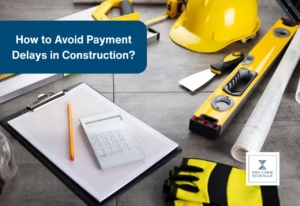No matter what industry you are in, we all have to deal with inflation. Material and resource prices are steadily increasing, and construction is no different. Delays in the supply chain and a lack of workers make it impossible to finish tasks on time or within budget. General contractors and project managers must be able to anticipate inflation and create plans and strategies to combat it.
In this article, we are here to help you understand construction inflation. We will give you several tips and tricks for navigating these tricky supply and demand cycles efficiently and effectively.
What is Construction Inflation?
Over time, people or organizations can lose the ability to buy things. This is called inflation. It means that your dollar will slowly lose its value tomorrow and go further down than it did today. It is actually a way to measure buying power.
For example, you can buy lumber at $506 per 1000 board feet today. However, in 3 days, lumber prices can shoot up to $527 per 1000 board feet. You end up paying more for something of the same quantity or size. This can significantly impact your project, especially since you usually finalize or lock in the budget early on. It is critical to be able to forecast estimates accurately and consider possible cost escalations.
What Causes the Inflation?
Many factors have contributed to the current level of inflation, not just in the United States but worldwide.
In present times, goods are hard to come by because of problems in the production and supply lines. Because of this, prices go up, and businesses and makers like you have to do the same to make up for the lack of supply. Inflation worldwide may also cause companies to decide to charge more because they know they can do so while still making more money.
The labor shortage is also one factor to consider. Employers continuously compete to hire skilled and competent workers. They need to raise wages, which drives up the cost of making goods and services.
The Current Status of Construction Inflation
Currently, there are no signs of construction inflation going down, as supply lines are still backed up, and interest rates are still high. The price of building materials has gone up, and builders are still looking for workers. Even though there are plenty of projects, finding skilled people to do them is getting harder and harder.
What Are the Effects of Construction Inflation
With the bad news about the building market, it is a good time for general contractors and project managers to take a step back and examine how to estimate budget and manage construction costs. Clients will only be satisfied with projects that take less time, cost less, or have money problems. Inflation is affecting all parts of the building.
Here are some things that you can focus on.
Estimating Costs
One way to reevaluate and lower building costs is to ensure that the initial estimates and final bids for a project consider current inflation rates. This includes all rising prices of materials and labor.
Take your time to research how much materials like lumber, steel, and concrete have increased in price over time. This way, you will have a solid basis for forecasting costs.
Winning Bids
Learning about how inflation affects building prices can help you plan and bid for appropriate projects for the current economy. Focusing on residential construction jobs that are easy on the wallet, like high-end renovations or building a custom home, can help keep clients happy and satisfied.
Creating Your Budget
As the market changes, you must review and rethink your prices regularly. For construction projects, this could mean adding a contingency fund to the budget to cover any unexpected costs. Adding this emergency fund to your plans will help your bottom line and prevent you from getting stuck with a hefty bill.
Being Flexible and Adaptable to Change
Keeping up with changes in the building business will help you prepare for setbacks. Your construction crew is your most important resource. Pay close attention to your employees and find and keep skilled, dependable workers who can help you finish your projects on time.
How to Deal with Construction Inflation?
As mentioned earlier, inflation can cause many things, such as high material costs, smaller budgets, longer wait times, delayed projects, or higher wages.
So, the next question you are probably wondering is, how can you overcome these problems and still maintain your project’s productivity and profitability? In this section, we look at ways to deal with construction inflation.
Communicate and Collaborate
The same things that affect you affect your clients. Everyone is feeling too much. Everyone needs to find new ways to spend their money efficiently, so it is critical to communicate and work together to ensure that you are on the same page.
Talk to your clients so that you both understand what you want to do and can carry out your plan within the limits of your current budget. Communicate with managers and workers to avoid as many problems as possible. Shipment delays, cost changes, or shifting project timelines need to be clearly written down and shared with everyone with a stake in the project.
Raise Your Prices
It can be scary to raise your prices, as you might think that no one will hire you if you are charging too much. But when things are bad, you must do what you must. Some costs should be passed on to your clients. People who want to work with you will understand, and your team will be able to help more people and take on more projects.
However, it is important to charge only the right amount. Before setting a price, you should determine your extra costs and how much you want to make. You can set your rates by looking at these numbers, billable hours, and profit margins.
Spread Out Your Assets and Resources
Do you need help getting materials? Are there a lot of people looking for building workers who can meet your deadline? Does it all seem impossible? As you ride this wave of inflation, consider considering expanding your customer base and the things you sell.
Now is an excellent time to try something new, whether you are starting a business, remodeling, or working on a particular project.
Keep An Eye on The Local and Foreign Markets
Given today’s volatile economy, it is essential to be informed about the current state of the market and supply chains. Keep up with recent events in your area and worldwide, and learn how they affect the global market. You can monitor how things like gas costs, trade policies, or material prices affect your business and keep track of them.
Set Early Planning and Payment
To get the best prices, you should accept designs, get quotes, and hire subcontractors as soon as possible. Early planning, onboarding, and paying your partners on time will make the budgeting process, buying materials, and, ultimately, the whole project go more smoothly.
Create an Efficient Warehouse and Storage Plan
You can also ensure that you have the materials you need when you need them without spending too much by buying them at fair prices and storing them in a warehouse. This way, they will be ready when you need them.
It would help if you did not buy everything on the market, but you can plan how you buy things. If there are certain things you always need or might need help getting in the future, you might want to buy more than you usually would.
Set up a Job Funnel
Everyone works hard to hire, manage, and keep workers. Due to limited funds and a unique shortage of workers, it is wise to have a plan for managing your employees.
Create A Marketing Plan
It may have been easy to find leads or jobs in the past, but with the construction industry’s competitive landscape, you will need a lot of work to do. With the economy the way it is right now, you should give your company’s marketing plan some more thought. Make a marketing budget, set goals, consider what you already know, and start planning whether you hire a small team to help you market your business or use your existing skills creatively.
Finalize Contractors
When prices go up, long-term plans may not be worth as much. Maintaining profitability can be difficult if the prices are set at a certain point in time and the costs of fulfilling the deal go up. It is important to note, though, that a price adjustment rule is possible.
Manage The Supply Chain
Supply chain management has to be strict but always flexible to keep building costs down. Depending on the materials used, making deals with sellers that are good for both sides and getting supplies from various places depends.
Optimize Designs
Together with architects and engineers, it is possible to find less expensive ways to build and furnish. The contractor could use a different building method or pick different materials to reduce unnecessary surface areas.
Utilize Construction Technology
In general, your construction company needs an easy way to manage things, make budgets, scale up or down, and communicate with each other. Construction technology, such as construction management software, can help you automate your processes and focus on the project’s different parts.
Construction Technology That You Can Consider to Battle Inflation
Even though prices are increasing, new technology makes it easier to manage projects and cut costs. Here are some examples.
Building Information Modeling (BIM)
BIM is a technology and a tool for creating 3D models of buildings. It helps keep costs down over a building’s life by storing all the information needed to run a construction job in one place.
The Internet of Things (IoT)
IoT allows real-world objects to connect and share information in real time by adding devices. In the construction industry, monitors can be built into tools, materials, and buildings themselves.
Artificial Intelligence (AI)
Controlling inflation is impossible, but controlling spending is possible with AI, mainly through management software that has AI built in. With its predictive analysis, it will be able to spot trends and predict changes in construction prices. This will help with better financial planning and the best use of resources.







